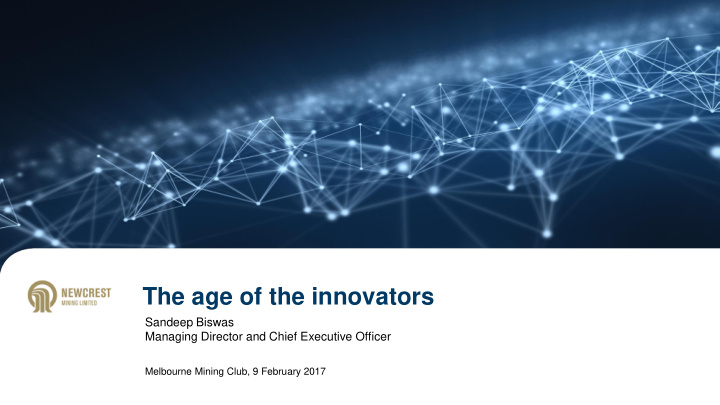



The age of the innovators Sandeep Biswas Managing Director and Chief Executive Officer Melbourne Mining Club, 9 February 2017
Innovation on the frontline Block cave CASE STUDY drawpoint Finding a safer way layout to conduct secondary break activities Water cannon operated from inside cab Remote drilling and charging 1
Mining industry has consistently adapted $8 Operating Cost Copper price (US$/lb) v Operating cost over time (US$/lb) Copper Price $6 $4 $2 Pre-1975 data is estimated $0 1900 1920 1940 1960 1980 2000 Source: R.Schodde, MinEx Consulting, 2010, The key drivers behind resource growth: an analysis of the copper industry over the last 100 years, supplemented by data from Wood Mackenzie Y axis represents US$/lb C1 costs (in real 2016$ terms) for period 1900 – 2016. Data prior to 1975 is estimated 2
Innovations have driven ~70% of reduction in cost base ~30% from increased scale Age Liberation Finding Big Scale-up Optimisation Control Digital • Flotation • Big deposits • Bulk explosives • Flash smelting • Process control • Automation Innovations • Leaching • Depression • Bulk pit mining • Geo-models • Optimisation • Remote operations • Smelting • WWII • Large mills • HPGRs • Deep caving • Artificial intelligence • Transport • Float cells • Copper SXEW • Instrumentation • Drones • Gravity • Caving • CIP • Bacterial oxidisation • Surface miners • Mineral scanners $200 US$/tonne of ore $160 $120 -70% $80 -60% -60% $40 Pre-1975 data is estimated $0 1900 1910 1920 1930 1940 1950 1960 1970 1980 1990 2000 2010 Source: R.Schodde, MinEx Consulting, 2010, The key drivers behind resource growth: an analysis of the copper industry over the last 100 years Y Axis represents estimated average operating costs (US$/tonne of ore) for copper mines in the Western World: 1900-2009 including transportation, smelting & refining and marketing costs Trendline is a order 4 polynomial, projecting data to 2016 3
But we are slow to apply innovations Application regularly lags ‘invention’ by many years Australian development Nominal industry innovation adoption time in year 8 Jameson flotation cell, 1987 9 Fine grind IsaMills, 1994 10 Flotation, 1905 Large scale open stoping, 1960s 15 Bulk explosives & 30 mechanised mining, 1950s 36 Digital process control, 1980s Still progressing 45 Still progressing High pressure grinding rolls, 1972 Sources: University of Queensland Professors Napier-Munn, McKee, Johnson, Knights, Chitombo
Rising to the challenge: Productivity & grades in decline 2004 to 2013 index CAGR Total Factor Productivity (MPI) Global mine productivity (Calculated) -3.5% p.a. -6.2% p.a. Average grade -2.7% estimate p.a. Source: McKinsey Basic Materials Institute (BMI Mining Model) 5 5
Processing innovations tackling declining grade CASE STUDY 20 % Selective Telfer processing throughput at Telfer Levers Selective 1 processing Modern 2 process control 6
Rising to the challenge: Increasing equipment utilisation Average Overall Equipment Efficiency (OEE) 92% 88% 85% 69% 39% 27% Underground Open pit Crushing Paper Oil and Oil mining mining & grinding mill Gas refining Source: McKinsey research and analytics 7
Mining companies use just a fraction of their data Data Data Visualisation capture management Execution Analytics & Infrastructure Automation <1% Operational information Data not used Data not in decision Data not communicated making Data not analyzed accessible Data not Failure Data not streamed points captured or stored Source: McKinsey Basic Materials Practice
Open collaboration on big data delivering results SAG mill surge events CASE STUDY Unearthed Hackathons This slide is not complete, so don’t Insights deliver worry about it, but I want the icon to improved ‘emphasise’ the experimental, performance collaborative and the fast adoption (and have ‘transformative vision’ as a secondary focus only). Dec 2016 July 2016 Hackathon 9
Rising to the challenge: More new mines will be deeper We are progressively exploring under deeper cover -500 Base metal deposits found in the world between 1900-2013 0 500 Depth (metres) 1000 Copper 1500 Nickel Zinc/Lead 2000 1900 1920 1940 1960 1980 2000 2020 10 N = 1034. NB. Size of bubble refers to ‘Moderate’, ‘Major’ and ‘Giant’ sized deposits. Excludes Nickel Laterite deposits. Source: R. Schodde, MinEx Consulting, The Global Shift to Undercover Exploration, 2014
Innovation key to making deep, low-grade deposits viable CASE STUDY Bulk underground mining at Cadia East Cadia 11
The age of the innovators Ben, here we want to bring it all together. The main message at the end is that the future belongs to the innovators. And that we need to increase our level of innovation to deal with the challenges we face. I don’t yet know what the best way to finish it is, will continue to think about this as you work on the other stuff. If you have any ideas though – an infographic, a metaphor, a collage of elements of previous slides - please send them my way. 12
Recommend
More recommend